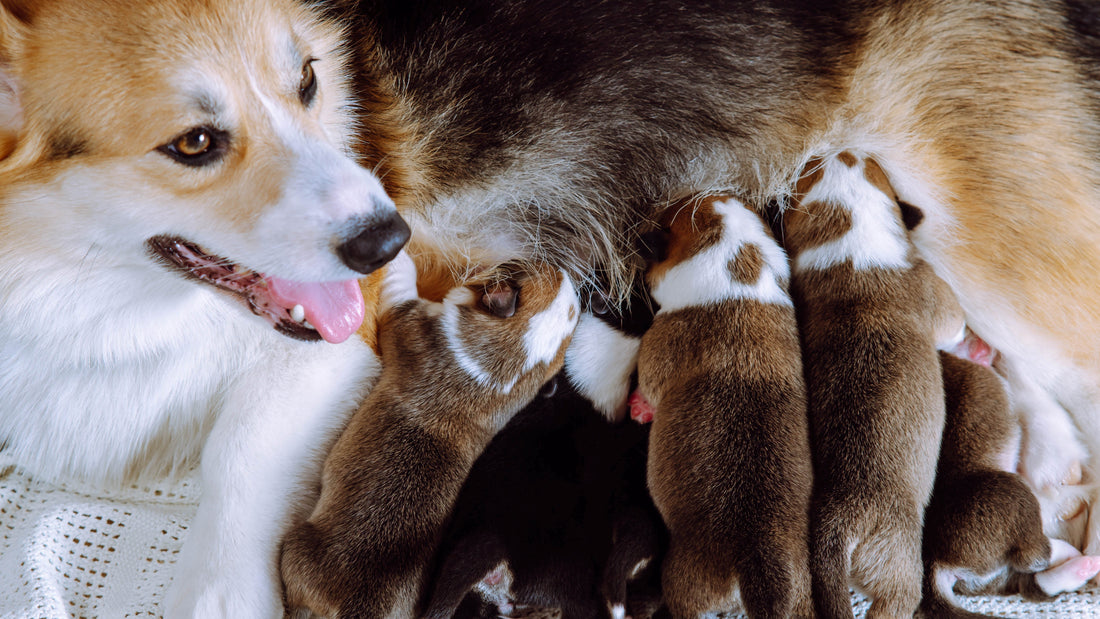
The Role of Oxytocin in Canine Labour, Bonding, and Milk Let-Down
Share
Oxytocin’s Role in Canine Labour, Bonding & Milk Let-Down
Learn how oxytocin supports labour, bonding, and milk let-down in dogs, plus what breeders can do to encourage natural release.
When a dam is close to whelping, her body begins a remarkable hormonal dance. One of the most important players in this process is oxytocin — a naturally occurring hormone that helps with labour contractions, bonding with puppies, and the release of milk for nursing. Understanding how oxytocin works can help breeders recognise normal whelping patterns and support their dams safely.
Oxytocin’s Role in Labour
Oxytocin is often call the "love hormone", but during labour it's also the "power hormone". As the cervix stretches and the uterus contracts, oxytocin levels rise, stimulating stronger contractions to move the puppies through the birth canal.
These rhythmic contractions are vital for effective whelping. If contractions become weak or stop altogether, it may indicate uterine inertia — a condition that sometimes requires veterinary support. Breeders should always monitor the dam’s progress closely and ensure she’s kept calm, warm, and hydrated.
Keeping essential items from your Whelping Supplies range close by — such as Calcium & other Supplements and Heating & Critical Care as well as your vets contact number — ensures you’re ready if labour stalls or intervention becomes necessary.
Oxytocin and Maternal Bonding
Once the puppies are born, oxytocin plays another key role — it promotes maternal bonding. When a mother licks her puppies clean and responds to their tiny squeaks, her oxytocin levels rise further, reinforcing caregiving behaviour.
Minimising stress in the whelping area helps this bonding process happen naturally. Gentle lighting, minimal disturbances, and clean, warm, soft bedding (F10 Veterinary Disinfectants and Heating & Critical Care) all create a calm environment that encourages nurturing behaviour.
Oxytocin and Milk Let-Down
After whelping, oxytocin also triggers the milk let-down reflex. When puppies suckle, the dam’s brain releases oxytocin, which causes the mammary glands to contract and release milk.
Breeders can support this process by allowing frequent nursing and ensuring pups are warm enough — cold puppies can’t suckle properly, which reduces stimulation and milk flow. If supplementation is needed, use products from Neonate Puppy Nutrition
such as puppy milk replacers and feeding kits to ensure every pup receives adequate nutrition.
Supporting Natural Oxytocin Release
Breeders can help promote oxytocin production naturally by:
- Providing a quiet, stress-free whelping space
- Allowing frequent skin and scent contact between dam and pups
- Avoiding unnecessary separation after birth
- Ensuring adequate hydration and calcium support, using quality Calcium & Supplements for Dogs
When Veterinary Oxytocin Is Needed
Sometimes, a veterinarian may administer synthetic oxytocin to help restart stalled labour, aid the passage of retained placentae or help milk let-down. This should only be done under professional supervision, as incorrect timing or dosage can cause complications such as uterine rupture or premature placental separation.
Never attempt to administer oxytocin injections without veterinary advice.
Final Thoughts
Oxytocin is one of the most remarkable hormones in the whelping process — it strengthens contractions, deepens maternal instinct, and ensures milk flows for hungry newborns. For breeders, supporting this natural cycle means focusing on calm handling, comfort, and nutrition. By understanding how oxytocin works, you can help ensure safer deliveries, stronger bonds, and healthier puppies from the very start.
